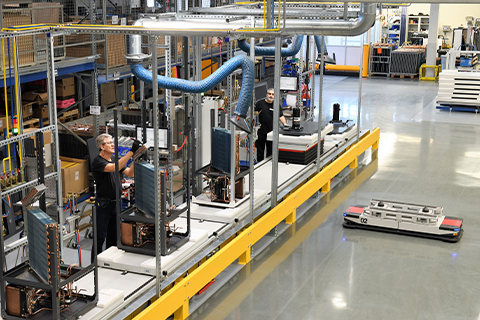Automation of production planning
Read more

Fluctuating market demand, delivery bottlenecks at suppliers and increased individualisation of products: We are living in challenging times that are making it increasingly difficult for processes along the supply chain to run smoothly. One reason for this is the organisational structure of manufacturing companies: This is because many manufacturers still focus too much on the set boundaries of their departments and operate with isolated IT solutions. The potential that remains untapped as a result and the advantages that an integrated process organisation brings instead become particularly clear when it comes to cooperation between production and intralogistics.
The cross-industry production control system, the cloud-based MES solution SAP Digital Manufacturing (SAP DM), already includes various functions ‘out-of-the-box’ to enable companies to implement end-to-end process modelling for common integration scenarios between production and logistics (SAP EWM).
Example scenarios for production supply through MES-controlled provision
A classic example of the digital mapping of overarching processes at shop floor level in conjunction with intralogistics is MES-controlled staging for production supply. In this scenario, users utilise SAP DM as the leading system for material staging in production. Thanks to deep integration and a linked data structure with the warehouse management software SAP EWM, material requirements, data on stocks and goods movements from production can be synchronised with those in the warehouse in real time.
Once the production order has been created and released in SAP ERP (ECC or S/4HANA), it is transferred to SAP DM. At the same time, material staging is triggered via the ERP system, which creates a production material requisition (PMR) in SAP EWM. Depending on the desired configuration, the warehouse management software then fulfils the requirement in the next step by either directly fulfilling individual requests (single-order staging) or supplying several orders in one go (multi-order staging).
In the second scenario, the staging requirements are first consolidated in the warehouse and the respective outbound deliveries are optimised using wave management integrated in SAP EWM, taking into account various criteria such as the number of components to be staged. In this way, picking in the warehouse as well as the internal flow of goods and the associated transport costs can be organised efficiently at shop floor level.
A brief explanation of the term ‘wave management’: A so-called wave is a grouping of warehouse request items that are processed together in subsequent processes. This grouping is used to control warehouse and intralogistics activities, such as picking, transfer postings and the internal material flow.
By linking the production order and the components loaded for it in SAP EWM with the help of a scanning process, the employee also ensures complete traceability of all components used.
The actual delivery to the line can take the form of pallets and containers or be automated using automated guided vehicles (AGVs). As a result, all components of the requested production orders are provided in the sequence specified by SAP DM for subsequent assembly at the desired workstations and, if necessary, further provisioning requests are also transferred to SAP EWM fully automatically.
Production supply through dynamic provision
React as quickly as possible to unscheduled events without affecting production performance: This is exactly what the integration of SAP DM to SAP EWM offers the option of dynamic provisioning. The concept aims to update the staging request created by SAP DM again if necessary, taking into account the latest information such as the scheduling and distribution of orders (in particular the assignment of relationships between resources, work centres and production supply areas).
The ‘Scheduling and Monitoring’ application of the SAP DM REO module can be used to flexibly reschedule the work centre intended to carry out an order operation. Thanks to the integration between SAP DM and SAP EWM, the planned PVB of the components is automatically adjusted before the provision of SAP EWM is triggered.
Do you still have questions? If you would like more information about digital manufacturing or are currently working on the digitalisation of your production processes, please do not hesitate to contact us. You can also find specific use cases in our white papers.
Request our white papers now and receive further exclusive information on Digital Manufacturing.
We look forward to hearing from you!